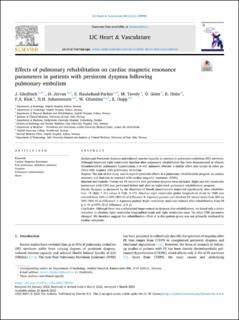Effects of pulmonary rehabilitation on cardiac magnetic resonance parameters in patients with persistent dyspnea following pulmonary embolism
Gleditsch, Jostein; Jervan, Øyvind; Haukeland-Parker, Stacey Marie; Tavoly, Mazdak; Geier, Oliver; Holst, Rene; Klok, F.A.; Johannessen, Hege Hølmo; Ghanima, Waleed; Hopp, Einar
Peer reviewed, Journal article
Published version
Permanent lenke
https://hdl.handle.net/11250/3046902Utgivelsesdato
2022Metadata
Vis full innførselSamlinger
Originalversjon
International journal of cardiology: Heart and Vasculature. 2022, 40, Artikkel 100995. 10.1016/j.ijcha.2022.100995Sammendrag
Background
Persistent dyspnea and reduced exercise capacity is common in pulmonary embolism (PE) survivors. Although improved right ventricular function after pulmonary rehabilitation has been demonstrated in chronic thromboembolic pulmonary hypertension, it is still unknown whether a similar effect also occurs in other patients with dyspnea after pulmonary embolism.
Purpose
The aim of this study was to explore potential effects of a pulmonary rehabilitation program on cardiac structure and function as assessed with cardiac magnetic resonance (CMR).
Material and methods
Twenty-six PE survivors with persistent dyspnea were included. Right and left ventricular assessment with CMR was performed before and after an eight-week pulmonary rehabilitation program.
Results
Dyspnea as measured by the Shortness of Breath Questionnaire improved significantly after rehabilitation: 15 (IQR: 7–31) versus 8 (IQR: 3–17). Absolute right ventricular global longitudinal strain by CMR was reduced from 19% to 18% (95% CI of difference: 0–3 percent points), and absolute RV lateral strain from 26% to 24% (95% CI of difference: 1–4 percent points). Right ventricular mass was reduced after rehabilitation from 49 g to 44 g (95% CI of difference: 2–8 g).
Conclusion
Although there was a substantial improvement in dyspnea after rehabilitation, we found only a minor reduction in absolute right ventricular longitudinal strain and right ventricular mass. No other CMR parameter changed. We therefore suggest that rehabilitation effect of in this patient group was not primarily mediated by cardiac adaptions.

